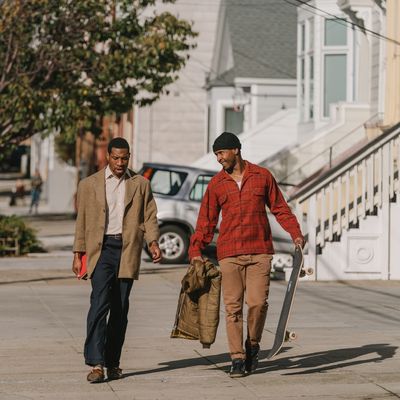
This review was originally published during 2019’s Sundance Film Festival. We are republishing the piece as the film expands into more theaters.
“You can’t hate it unless you love it,” a character says about San Francisco near the end of Joe Talbot’s The Last Black Man in San Francisco, and it’s one of the truest things I’ve ever heard anyone say about a city. The speaker is Jimmie Fails (played by Jimmie Fails, who receives a story credit for the semi-autobiographical role), and he’s talking to two young women on a bus who are complaining about the city they’ve gentrified. There isn’t judgment in his voice, however; by this point, Jimmie seems to have become almost Zen about the fact that the San Francisco he loved and grew up in is changing into something else, yet another step in a long line of something elses reaching back decades.
Jimmie is an African-American man who longs to return to the elegant, sprawling Victorian-style home in which he grew up, in the city’s Fillmore District, an area once known as the “Harlem of the West.” The neighborhood has changed quite a bit, and the residence has been owned for 12 years by an older white couple. But this house, we’re told, is different: Despite the 19th-century architecture, it was purportedly built by Jimmie’s grandfather with his own hands back in 1946. Jimmie doesn’t approve of the way that the current owners are maintaining it; when they’re not there, he sneaks in and paints the windows and takes care of the plants.
Jimmie lives in a cramped room on the outskirts of the city with his best friend Montgomery (Jonathan Majors), an aspiring playwright. Together, the two men walk the streets lamenting the passing of the city they knew as kids, now replaced by tech bros and other young professionals. The two friends are out of place wherever they go, however; back in their neighborhood, they get hounded and harassed by a group of guys who regularly hang out on the corner. But even these tough young men have stories of their own, and lives more complicated than they let on.
This is a film of shifting moods and occasionally contradictory narratives. It’s as much about delusion as it is about gentrification, and as much about friendship as it is about solitude. (The title turns out to be somewhat misleading, purposefully.) Jimmie invests his reclaimed house with so much emotional urgency — it seems central to his self-image — but his idea of it also feels fixed and unchanging. The house represents, perhaps, the long-gone warmth and unity of a family that has since fractured, casting its members to different corners of society. His love and care for the building is moving, even heartbreaking, but it also suggests an inability to move on. Especially when there seems to be so much more warmth back in Montgomery’s cramped little house, where the two of them regularly watch noir classics on TV with Montgomery’s nearly blind grandfather, played by Danny Glover.
Talbot is a striking filmmaker, giving his film both a lived-in authenticity — the location work is evocative, and he’s filled the screen with oddball locals — and a fairy-tale hermeticism. Inside the ancient Victorian, Jimmie and Montgomery act as if they’ve stepped out of time, perusing over bound volumes of Dickens and fussing over dusty organs. The director lets these stylistic and tonal contradictions vie with one another. Nobody is any one thing, the film wants to tell us — which ironically turns out to be an easier thing to say about other people than about oneself.


